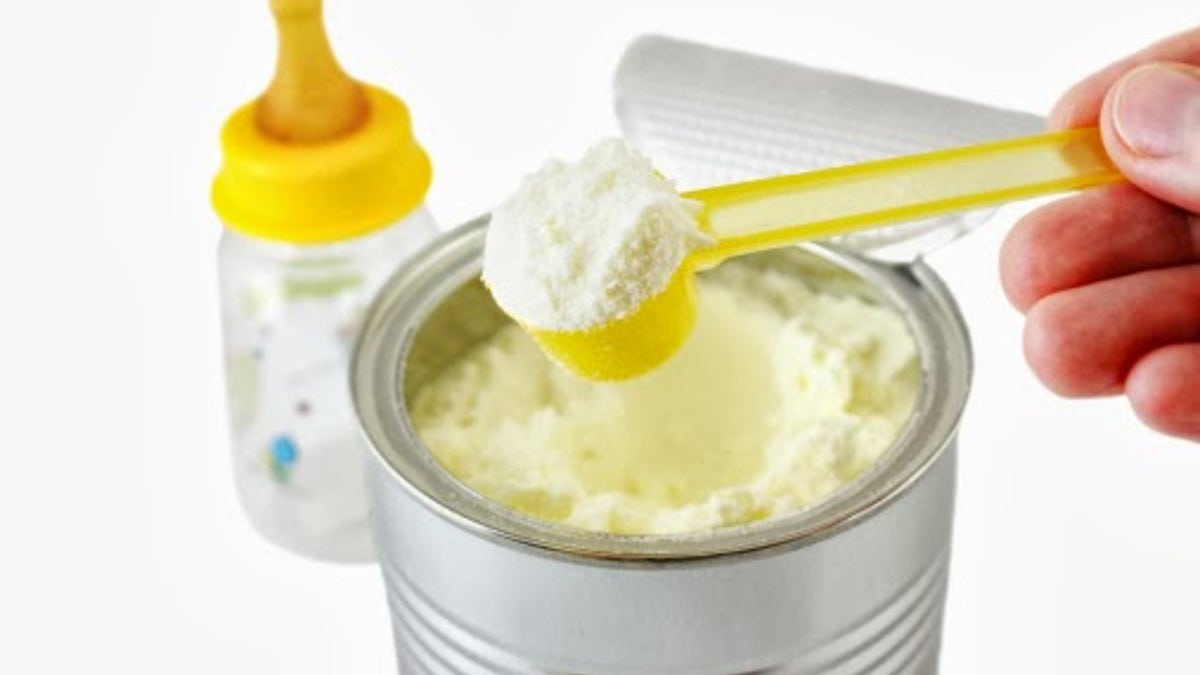A history of food substitutes, from saccharin to soylent
{{#rendered}} {{/rendered}}Let’s hear it for mankind: We’ve been trying to replace food nearly as long as we’ve been preparing it. Soylent, a “powdered food alternative” currently grabbing headlines and investors, is the latest and most ambitious in a long line of edible things trying to be other edible things.
Food substitutes are often accompanied by controversy. Over the last century, synthetic food has been touted as a solution to world hunger and an unethical aberration; it’s augured utopia and dystopia. Mostly, though, it’s provided an excuse for people to try absurd new things. We’ve catalogued some of the more memorable creations for your enjoyment; accept no substitutes.
1. 1867: Baby Formula

Baby Milk Formula (iStock)
Time was, if you didn’t want to breastfeed your kids, you’d just hire someone else to do it. This arrangement held together nicely for many centuries; then Elijah Pratt invented the rubber nipple in 1845 and people got to thinking. By 1867, a German chemist named Justus von Liebig had created what he called “Liebig’s Soluble Food for Babies,” a powdered formula of potassium bicarbonate, wheat flour, and malt flour, intended to be mixed with warm cow’s milk. An immediate hit, it gave rise to a slew of competitors, including Nestlé’s Food, created by a certain fledgling company that now happens to the largest producer of packaged food in the world. Baby formula alone is a multibillion-dollar industry.
{{#rendered}} {{/rendered}}2. 1869: Whale Oil

(Bon Appetit)
Whale blubber was once used to make just about everything: it was found in detergents and dyes, in transmission fluids and aircraft engine lubricants, in candles and lamps. It was only a matter of time, then, until someone decided to cook with it. Early margarines, cooking oils, and butter substitutes relied on baleen whale oil as the primary raw material—in 1916, fueled by the austerity of the first World War, British consumption of margarine surpassed butter for the first time, and whale-oil sales soared.
3. 1878: Saccharin
(Bon Appetit)
Forget aspartame and sucralose: saccharin is the fake sugar that started it all. Say it’s 1878 and you’re a chemist working with the derivatives of coal tar—fun, right? So fun that after a long day’s work, you’ll want to lick your hand. That’s something like what Constantin Fahlberg did when he discovered benzoic sulfimide at Johns Hopkins University. As names go, “benzoic sulfimide” doesn’t exactly scream “artificial sweetener,” so Fahlberg rechristened it saccharin, after the Latin for “sweet”; production began posthaste. Saccharin had a rocky start—the USDA flirted with the idea of making sugar substitutes illegal—but its popularity climbed thanks to a World War I sugar shortage. The diet crazes of the ‘60s and ‘70s helped sales, too, most notably of Sweet ‘N Low, which remains the best selling saccharin-based sweetener.
4. 1895: Postum
(Bon Appetit)
C. W. Post, of Post Cereal fame, invented this coffee substitute in 1895. Made from wheat bran, wheat, molasses, and the maltodextrin from corn, it’s missing a pretty critical ingredient—caffeine. But what strikes us as a major deterrent was actually a marketing point in the early 20th century. Ads for Postum sometimes featured “Mr. Coffee Nerves,” a demonic, ghostly archvillain who stood for all that is evil about caffeine: anxiety, irritability, the jitters. Postum sold briskly during World War II, when coffee was rationed and the deprived, uncaffeinated populace had no choice but to pursue alternative stimulation.
{{#rendered}} {{/rendered}}5. 1920: Nonalcoholic Beer
(O'Doul's)
Poor O'Doul's. Of the many nonalcoholic beers out there, it sits at the butt end of the most jokes, a token object of frat-boy malice; Urban Dictionary defines it as "the most pointless beverage in the world." Really, there's a low-alcohol culture dating back to medieval times, when people needed a drink that was cleaner than water (which was often contaminated) but didn't get you too buzzed to work.
More recently, making nonalcoholic beer allowed American breweries to stay open during Prohibition, which began in 1920. Removing the alcohol from beer isn’t too hard; alcohol has a lower boiling point than water, so if you heat the brew, it’s the first thing to go. Be sure to trot out these factoids next time you encounter a sneering frat boy. (We hope it's not in this lifetime.)
6. 1959: Tang
(Retroland U.S.A.)
Legend has it that NASA invented Tang, but legend is wrong. In fact, the food scientist William A. Mitchell is responsible for this “aromatic, orangy-tasting powder,” as it was first marketed in 1959. Brimming with sugar, citric acid, artificial coloring, and a full day’s serving of Vitamin C, Tang was intended as a hip alternative to orange juice—an easy way to signify, at the breakfast table, that you were in step with the march of American progress. But only when John Glenn drank it in space did Tang begin to fly off grocery shelves.
{{#rendered}} {{/rendered}}7. 1960: Surimi
(iStock)
Problem one: Crab meat is expensive. Problem two: The modern, industrialized fish business has plenty of unused fish parts on its hands. If you can imagine one elegant, if suspicious, solution to this problem, you’re probably thinking of surimi, a processed purée of gelatinous fish paste and additives (think salt, egg whites, MSG, starches, etc.) invented in the 1960s. Surimi, which means “ground meat” in Japanese, is used to imitate crab, lobster, and other expensive seafood; if you’ve ever had a California roll from the sushi place on the corner, you’ve almost certainly had surimi. Japan and the U.S. produce most of it; it’s estimated that 2 to 3 percent of the world’s annual fish catch is used in production.
For more fun facts about food substitues, check out the full history.
More from Bon Appétit
{{#rendered}} {{/rendered}}7 Most Common French Toast Mistakes
10 Snacks You Thought Were Healthy But Really Aren't
{{#rendered}} {{/rendered}}